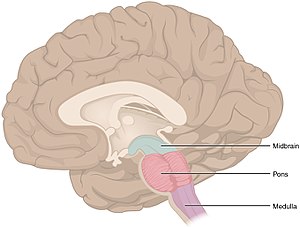Medulla oblongata
| Medulla oblongata | |
|---|---|

Medulla oblongata purple, part of the brain stem colored
|
|

Section of the medulla oblongata at about the middle of the olivary body.
|
|
| Details | |
| Part of | Brain stem |
| Identifiers | |
| Latin | Medulla oblongata, myelencephalon |
| MeSH | A08.186.211.132.810.406 |
| NeuroNames | hier-695 |
| NeuroLex ID | Medulla oblongata |
| TA | A14.1.03.003 |
| FMA | 62004 |
|
Anatomical terms of neuroanatomy
[]
|
|
The medulla oblongata (or medulla) is located in the hindbrain, anterior to the cerebellum. It is a cone-shaped neuronal mass responsible for autonomic (involuntary) functions ranging from vomiting to sneezing. The medulla contains the cardiac, respiratory, vomiting and vasomotor centers and therefore deals with the autonomic functions of breathing, heart rate and blood pressure.
The bulb is an archaic term for the medulla oblongata and in modern clinical usage the word bulbar (as in bulbar palsy) is retained for terms that relate to the medulla oblongata, particularly in reference to medical conditions. The word bulbar can refer to the nerves and tracts connected to the medulla, and also by association to those muscles innervated, such as those of the tongue, pharynx and larynx.
The medulla can be thought of as being in two parts:
The anterior median fissure contains a fold of pia mater, and extends along the length of the medulla oblongata. It ends at the lower border of the pons in a small triangular area, termed the foramen cecum. On either side of this fissure are raised areas termed the medullary pyramids. The pyramids house the pyramidal tracts–the corticospinal and the corticobulbar tracts of the nervous system. At the caudal part of the medulla these tracts cross over in the decussation of the pyramids obscuring the fissure at this point. Some other fibers that originate from the anterior median fissure above the decussation of the pyramids and run laterally across the surface of the pons are known as the anterior external arcuate fibers.
...
Wikipedia
